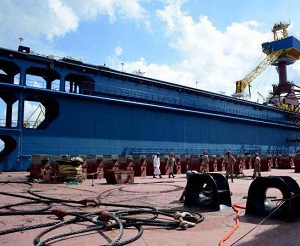 The arrival to the port of Havana of a modern floating dock, to repair Panamax ships, caused quite a stir among capital city residents along the waterfront, and signaled Cuba’s returns to the international market for maritime repairs.
The arrival to the port of Havana of a modern floating dock, to repair Panamax ships, caused quite a stir among capital city residents along the waterfront, and signaled Cuba’s returns to the international market for maritime repairs.
The floating structure was manufactured in 18 months, in the People’s Republic of China, and was transported to the island by the second largest submersible supercargo ship in the world, in a 52-day voyage through the Indian and Atlantic oceans, plus the Caribbean Sea.
Sources consulted by Granma International reported that by March 2020, maritime repairs will begin on the Floating Dock II, acquired by the country through a Chinese government loan. The structure will allow for work on ships of up to 65,000 tons displacement.
This is not the first floating dock of this type used in the country, but it is the most modern, since the last one with the capacity to repair Panamax ships was decommissioned in 2012, explained Alejandro García Corrales, general director of the Maritime Port Transport Enterprise Group (Gemar).Since then, he added, Cuba has had only smaller dry docks, while efforts continued to acquire one with these characteristics.Construction of the floating structure in China began in 2017 with the participation of Cuba’s Casablanca Shipyards, which provided technical specifications for the design based on experience gained with such docks in the past.
On October 27, the submersible supercargo vessel transporting the dock reached its maneuvering position on the city’s coastline to begin the process of floating the new dock, entering Havana Bay, and placing the structure at the shipyard.
“This maneuver normally involves the transport ship beginning an intentional sinking to allow for the release of the dock. The process was conducted as planned, beginning at noon and concluding at 1:00am in the midnight hours,” García explained.
The structure is not yet secured in its location, since planned technical works must be completed to ensure safety in its final position, located within the bay, alongside the Casablanca Shipyards’ facilities, the entity that will operate the floating dock.
The dock is designed to service Cuban ships and those of foreign fleets that sign contracts with Casablanca Shipyards, since the maritime repair market offers significant opportunities, García commented.He noted that situations arise with ships traveling in the area that break down, obliging them to seek a shipyard close at hand to make emergency repairs. Having this dock allows the shipyard to offer these services, he added.
Similarly, services can be provided if emergencies occur within the bay or at sites close to Cuba, which require immediate dry docking orcareening for repair.”This dock will be an important source of foreign exchange income for the country’s economy, and for the development of our fleet and the transportation system in general,” he stated.The economic, commercial, and financial blockade imposed by the United States government on Cuba also impacts the shipyard’s work with the new floating dock, with shipping companies that have requested maintenance in Havana withdrawing contracts, since U.S. sanctions prohibit any vessel that has visited a Cuban port from entering the U.S. for a six-month period.
FLOATING DOCK II
Once the start-up begins, vessels will be able to request dry-docking for an 18-day period, or 22 for maintenance, although these figures vary depending on the number of operators available – about 130 daily in the stage initial – and on the job to be completed, said Johannes Milián, the shipyard’s general manager.”Estimates indicate that income generated from the work, beginning next year, will pay for the dock, and also contribute to the national economy,” he added.For work on the dock, Casablanca Shipyards is offering a maritime repair package, which includes plates for hull maintenance, degreasing supplies, electrical materials, cables, and pressurized water, Milián stated.In the case of painting, shippers can request this service with workers on the dock adhering to specifications established by suppliers for each type of vessel.It is expected that the new Cuban dock will have a useful life of at least 30 years. During the initial 10, few repairs will be required on the new structure, and from that moment on, a budget will be allocated for modifications or renovation, and replacement of machinery.
IN FIGURES
The floating dock has the following characteristics:
240 meters in length
48 m exterior.
36 m of useful beam (width)
1 crane on each band
20 tons lifting capacity of each crane
22,000 tons of lifting capacity
170 supports in the central line
80 supports on the lateral lines Source: Grupo Empresarial de Transporte Marítimo Portuario
(Granma)